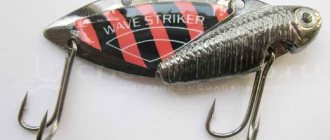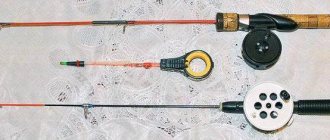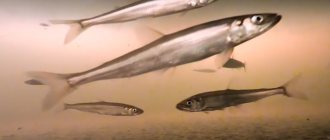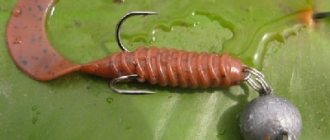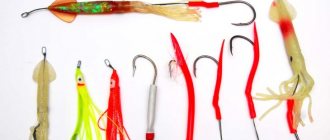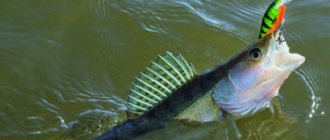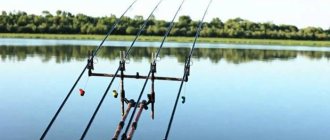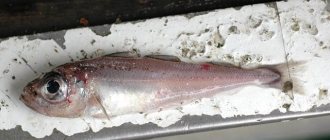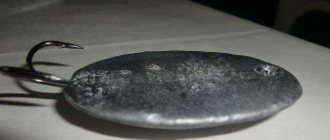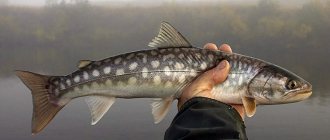Habitats and features of smelt fishing
The fresh meat of this fish has a cucumber smell, but it disappears after heat treatment. High-calorie fish can be fried in a frying pan without adding fat. The unique taste and benefits for the body of this fish compels fishermen to go out onto the icy surface of the Gulf of Finland every year.
Smelt is a small marine predator belonging to the salmon order. It lives in slightly saline waters and swims to river mouths to spawn. The timing of spawning is affected by weather conditions. Schools of freshwater species are found in all large bodies of water in North-West Russia, as well as in the Volga reservoirs. This fish loves cool water, so biting activity is observed in the autumn-winter period.
It feeds on small crustaceans, so the main smelt gear is a smelt jig and small winter spoons. They are often caught using animal baits: worms, bloodworms, pieces of fish, shellfish meat. The school does not stay in one place for a long time, so bait does not promote active biting.
Various gears are used for catching smelt in the spring: a light rod with a thin fishing line, preferably camouflage, blue or green. In the spring months, this fish is also caught with spoons and tyrants.
Where to catch smelt in winter
This small fish prefers to gather in large, numerous schools, the mass of which can reach a ton. Moreover, there may be several such flocks. It is difficult to even imagine what density of fish is in a certain area of the reservoir.
To determine the location of a school of smelt, just look at the surface of a reservoir covered with ice. Where there is the greatest concentration of fishermen, there is a school of fish. At the same time, the density of fishermen is also amazing: there can be thousands of them per square kilometer. Despite this, each of them will be able to catch several kilograms of fish. This suggests that there are several large schools of smelt in the immediate vicinity of fishermen.
Smelt prefers to be in places where small rivers flow into large ones. This is due to the fact that it will go to small rivers to spawn. Therefore, river mouths are its favorite stopping place. While in this place, she prepares to go to spawn.
Sometimes smelt are caught from a depth of about 20 meters; on rivers with shallower depths, they bite at a depth of 4 to 8 meters. This fish prefers places with a flat bottom, unlike other types of fish that go to pits with significant depths for the winter.
It is caught between the bottom and up to 1 meter away from the bottom. The bait is played by raising it to a height of 1 meter and lowering it to the bottom. It is on this horizon that the bites occur. Although there are cases when smelt accumulates at other depths. In this case, a lot depends on weather conditions.
Tackle
The most important tackle is the fishing line. It should be thin: from 0.25 mm to 0.2 mm. It will not be possible to cut it off from a small predator, and a thread that is too thick will create unnecessary problems. There are no requirements for the fishing rod, so you can fish with a simple winter fishing rod (even without a reel) made of foam plastic.
A rod with a missing nod is considered popular. If necessary, you can use a small foam ball painted in a bright color as a nod. Jigs serve as bait for smelt in winter.
The diameter of the line for catching smelt is somewhere between 0.27 mm – 0.28 mm – 0.3 mm.
Basically, fishing line of this diameter is used for smelt. I would not recommend using a fishing line with a thinner diameter, this will make fishing much more difficult - it will get tangled more often.
It is better to use fishing line with increased wear resistance . Akara GLX brand fishing line , a line with fluorocarbon coating, which also increases its wear resistance. This will be the main line (Akara GLX Abrasion Resistant Brown 150 m).
For leashes, I will use a line of the same type (Akara GLX ICE Clear line 30 m), only transparent and with a diameter of 0.2 mm . I probably wouldn’t recommend using thinner line for leashes either. I had experience when I tried to use a thinner line of 0.12 mm, because... Smelt is not a large fish, so why use a thick fishing line? But it ended with me losing 4 jigs on one fishing trip. Moreover, for completely unknown reasons. There was a bit of a bite on the fishing rod, then the biting stopped, I pulled out the fishing rod - there was no jig there. Somehow, I don’t know, maybe the pike perch took a bite, but this is unlikely, I have never felt this when hooking.
With a thin fishing line, jigs will be lost more often, and most importantly, jigs on leashes will be more likely to get confused with the main fishing line . Those. if the main line still has a certain rigidity, then the jigs are less likely to get confused with the main line, this is important.
Lures
When fishing with a small bait (4 mm), the bite will be maximum, but small specimens will also be caught. If you fish with large bait, most of the catch will consist of large fish, but the bites will be less frequent. Some fishermen are attracted by luminous baits - these are luminous or phosphor jigs.
How to tie jigs for smelt
Beginner fishermen are interested in how to tie the bait correctly: you can tie jig hooks for smelt using two types of knots. For jigs with an eye, knots such as Trilene, Improved, Palomor are used. Tying jigs is no more difficult than tying a hook.
For a jig with a hole, it is better to use self-tightening knots. The line is attached to the hook after it has been pulled through the body of the bait.
Where and what to catch smelt in winter
During the winter months, this species is found near river mouths. Individuals swim there to spawn. These are the places to look. The fishing depth can be great. In some rivers this fish goes 20 m, while in others it swims in the range from 4 to 8 m.
You can catch it throughout the day, but when it starts to get dark, the bite becomes much more active. At night, you can attract fish with a beam of light directed into the ice hole, then the bites follow one after another. To do this, fishermen use a flashlight or spotlight. For winter fishing, jigs are used.
Tackle
The most important tackle is the fishing line. It should be thin: from 0.25 mm to 0.2 mm. It will not be possible to cut it off from a small predator, and a thread that is too thick will create unnecessary problems. There are no requirements for the fishing rod, so you can fish with a simple winter fishing rod (even without a reel) made of foam plastic.
A rod with a missing nod is considered popular. If necessary, you can use a small foam ball painted in a bright color as a nod. Jigs serve as bait for smelt in winter.
Lures
When fishing with a small bait (4 mm), the bite will be maximum, but small specimens will also be caught. If you fish with large bait, most of the catch will consist of large fish, but the bites will be less frequent. Some fishermen are attracted by luminous baits - these are luminous or phosphor jigs.
How to tie jigs for smelt
Beginner fishermen are interested in how to tie the bait correctly: you can tie jig hooks for smelt using two types of knots. For jigs with an eye, knots such as Trilene, Improved, Palomor are used. Tying jigs is no more difficult than tying a hook.
For a jig with a hole, it is better to use self-tightening knots. The line is attached to the hook after it has been pulled through the body of the bait.
Types of spinners for smelt
Using a spinner gives an amazing result, because the fish cannot ignore the shiny bait, which, moreover, can glow in the dark.
They are small in size, made of different metal alloys. There are several types of spinners for catching smelt; each model has its own characteristics and disadvantages, which must be taken into account before use.
Passive spinner
Such models are designed for fishing with a rod, but there is no need to use special trolling techniques with them. Combined tackle is used together with jigs and spinners, which glow in the dark. They not only catch effectively, but also lure fish to the hunting area.
The models that are elongated, lightweight, and silver in color are rightfully considered the most catchy. You can take both cupronickel and silver plated ones. Be sure to be covered on one side with a luminous composition.
Such spoons reliably imitate small fish - herring, which smelt likes to hunt. These baits are attached to the main fishing line on a separate leash; several pieces can be used simultaneously at a short distance from each other.
The main rule to follow is ease. After all, if the weight is large, then the bait will simply hang on the leash and hang lifelessly. In this case, it will neither attract nor interest the fish.
To increase the amount of prey, you should use several fishing rods at the same time. They more reliably imitate a small school of frightened fish, so they can work more productively by attracting smelt.
To further increase the chance of catching prey, attach a small piece of fish fillet to the hook. It is necessary to play, this can be done by raising and lowering the rod. If it starts to glow less brightly, then you should remove (scrape off) the top layer of paint a little, and the brightness will return.
Spinner for smelt
In domestic reservoirs, smelt is caught quite well with a spoon . Small-sized metal spoons, coated on one side with a special compound, and also capable of glowing in the dark, are attached to fishing rods along with jigs.
However, over the past few years, new baits have begun to be actively used - the so-called “active” spinners. In general, it is worth saying that spinners for smelt have been used for many years.
Passive spinner
Passive lures for catching smelt involve fishing with fishing rods designed for catching smelt, without the use of specialized lure techniques . In catching smelt, combined tackle, which consists of a spinner on a fishing line and phosphorus jigs, has proven itself to be excellent.
Such combined baits for smelt also serve as excellent means of luring them to the fishing spot.
Light lures with an elongated shape show excellent productivity. The color of these spinners is silver .
The spoon should be covered on one side with a light composition, thereby achieving maximum fish attraction.
The bait must be attached to the main line using a separate leash . Several rods with similar tackle will need to be installed close to each other, and a piece of fish fillet must be placed on the hook of the spinner. To play effectively, you will need to play with the rod in a timely manner.
“Active” spoon and smelt: fishing technique with a silver “plane”
It’s worth saying right away that it is quite possible to use one hole . The search for fish can be done by lifting the spoon from the bottom of the reservoir, while searching for the horizon by touch, in the area of which fish feed. As soon as smelt bites appear, we fix the working depth for subsequent catching of smelt.
In more detail: first there is a sharp swing, after which the gear is freely planned in the water space. Then there is a four-second pause, during which a small game of nodding follows so that the tackle does not shake too intensely.
How to prepare bait for carp? In the article you will find several recipes for preparing bait for this fish.
This article will talk about the types of floats and their use in practice.
Preparing gear
Catching smelt in winter does not require any specific gear. The equipment is also quite simple and easy to make yourself. Depending on the chosen fishing method, the set of gear elements may differ: 1. Any rod for winter fishing will be suitable as a fishing rod. 2. You can install a reel, but many people do without it. 3. The main fishing line is monofilament intended for winter conditions, with a thickness of 0.08 to 0.25 mm. The diameter depends on further equipment and fishing conditions. 4. Lead line, the thickness of which is slightly less than the diameter of the main one. 5. When installing the nod, use a signaling device made of a metal spring, the length of which is 8-10 cm. 6. Hooks, jigs or spinners. At different periods of winter, smelt may prefer different baits. Therefore, anglers often prepare several rigs in advance and take various baits with them. 7. A weight of any shape at the discretion of the fisherman. The weight depends on the depth of fishing and the presence of current. 8. Float.
Secrets of smelt fishing
22 January 2013 16:07
The most commonly used smelt fishing rod is a regular “filly” made of pressed foam or the simplest fishing rod with a foam handle, a medium-sized reel and stop legs. The whip on a smelt fishing rod is quite short (15-20cm), made of plastic or composite. The nod is chosen to be large enough, with a clearly visible ball at the end. The nod should not interfere with the free movement of the tackle or fray the fishing line. For catching small and medium smelt in a gentle current, soft spring nods are suitable. In case of strong current or catching large smelt, nods on a stiff spring are required. The most common diameter of smelt fishing line is 0.25-0.3 mm. Thinner fishing line, although it is better “camouflaged” in the water, is more susceptible to tangling when fishing and laying on the reel. A piece of thinner fishing line with short leads equipped with jigs (usually 2-3 pieces) is attached to the main fishing line through a swivel. Installation of thinner leashes is also possible directly on the main thick fishing line. The topmost leashes should also be the shortest. The distance between the leashes is chosen empirically. Many smelt fishermen equip their gear with a so-called “whatnot” - a group of 2-3 jigs located 1.5-2 meters above the lowest jig. This method of equipment often brings a catch from the largest smelt feeding in the shallow water. At the end of the tackle there is a sinker, the weight of which is selected depending on the depth of fishing and the strength of the current. To quickly change the sinker, it is best to use a carabiner. To catch smelt, you need to have several already equipped fishing rods in order not to waste time on the ice, untangling or re-equipping broken gear.
Smelt jigs are distinguished by a voluminous phosphor head with a large hook and a short shank. Depending on the composition of the light accumulator, smelt jigs
may vary in color - from white to yellow-green.
It is better to have jigs of different colors in your arsenal to select the most catchy ones in a particular place. During the fishing process, it makes sense to “recharge” the jigs with a flashlight or change them for fresher and brighter ones. smelt jigs
, which have a red band near the base of the hook, are more noticeable in the snow. Over time, phosphorus loses its light-accumulating properties, so do not forget to regularly (every season) change smelt jigs. It is necessary to store phosphorus jigs only in special tightly closed boxes or bags without access to sunlight.
Bait for catching smelt can be very diverse. The main condition is that the bait must be fresh and caught in the same body of water. The most commonly used bait is perch caught along the route to the smelt fishing spot. To catch perch, it is advisable to have in your arsenal a fishing rod equipped with a vertical spoon, preferably a classic one - a “diamond”, “sleeper” or “airplane”. Don’t be lazy and fillet the perch – such bait will be much more attractive than a simple piece with skin. When the fillet is finished, you can successfully use the meat of the smelt itself as bait. Many fishermen use ruffe or pieces of any local fry as smelt bait - roach, bleak, bream, etc. In the latter case, you will have to stock up on separate jig tackle and bloodworms.
Smelt is a schooling fish and you can quickly identify its accumulation under the ice by the presence of a large group of fishermen “semaphore” with their hands when fishing.
If you want to fish alone, look for deep drops, places with rocky ridges or just any noticeable change in the flat terrain. The formed hummocks, signaling the presence of a depth difference in a given area, can help in the search for such promising places. Liked? Share with your friends!
Smelt fishing rod and equipment
The choice of fishing rod for smelt is of great importance for many reasons. Since winter smelt fishing requires high activity from the fisherman, you have to fish with several fishing rods at once and at great depths, and sometimes you have to quickly change the place if there is no bite. That is, collect all the gear, quickly move to another place, and reinstall all the fishing rods. Therefore, smelt fishing rods must have the ability to quickly reel in fishing line and the ability to quickly attach hooks. And also the specificity of winter fishing for smelt is that when biting, you need to sharply hook the fishing rod and throw it onto the ice, and then pull the line out with your hands. And the smelt fishing rod must withstand such repeated falls and not break.
Usually, when fishing for smelt, each fisherman has several fishing rods, many even arrange too many fishing rods, 15-20 pieces each. But realistically, it is enough to have 5-10 fishing rods with you for smelt, and it is better to place no more than 8 fishing rods, since it is inconvenient to maintain, change bait and light jigs for smelt with more than 8 fishing rods. And 1-2 fishing rods remain in reserve in case the main fishing rods get tangled, and this happens quite often, and in the cold and wind it is easier to get a reserve fishing rod than to untangle the beard on the fishing line. And be sure to have a trolling rod with you, equipped with a smelt lure. Sometimes smelt are caught very successfully using a spoon.
There is another restriction on the number of fishing rods for catching smelt, which in the fishing rules entails a financial fine. There should be no more than 10 hooks or jigs per fisherman. In winter, the number of hooks in smelt gear placed at the holes can be counted right on the ice by a fishery control and supervision inspector who suddenly appears and issues a fine if the rules are violated. Such situations have already begun to occur in the Gulf of Finland during winter smelt fishing. But so far such inspections are not very frequent.
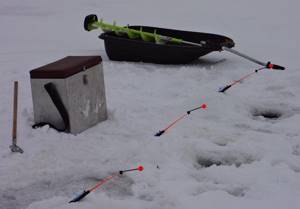
So, based on the above requirements, the smelt fishing rod must be durable and equipped with a reel for fishing line, and the fishing rod must float if it falls into the hole. Based on the experience of catching smelt, the best smelt fishing rod was one made by hand from finely porous and durable foam, which has a yellowish tint. Such foam was usually used for large floats in commercial fishing nets; such floats could be found on the shore of the bay, washed up by a storm.
Oblong bars are cut from polystyrene foam, with dimensions of 15-18 cm in length, 3.5-4.5 cm in width and 2.0-3.0 cm in thickness. You need such bars for fishing rods so that the fishing rod can be conveniently taken even in a mitten. A whip is glued into the block, and a simple and small coil of caprolon is tied to the block with electrical tape. Now such a reel and such foam can be bought on the fishing market, but the price is much higher than for ordinary Chinese fishing rods with a reel.
If it’s difficult to make a fishing rod for smelt yourself, then you shouldn’t buy the cheapest one, now there are a lot of poor quality winter fishing rods on sale, and you can still choose a shock-resistant and comfortable fishing rod. If the fishing rod is made of plastic, then it should be frost-resistant, the plastic should not break in the cold, and you should also not take a fishing rod made of white foam, as it is very fragile and breaks instantly with a slight impact or stress. The reel must also withstand falls on ice and frosty weather.
The whip on a smelt fishing rod is also very important and sometimes breaks when hooking, especially in the cold. When choosing a whip for a fishing rod, you will have to experiment, try different ones to find one that is durable and flexible. There are many different whips sold in fishing stores, and you can’t immediately tell by their appearance how high quality they are, so there is one way: take a whip with you fishing and try it on a couple of fishing rods; if the tests are successful, then you can equip all your smelt fishing rods with these with whips. If the whip is too long, then it can be trimmed; a length of 20-25 cm is sufficient, taking into account the fact that a 3-4 cm part of the whip will be inserted into the fishing rod.
To rig a fishing rod for smelt in winter, you definitely need a nod on the whip. For smelt fishing, it is better to use a spring nod with a red ball at the tip. This nod is not expensive, easy to use and quite durable. The basic requirements for a spring nod, a spring in terms of its elasticity is needed with average indicators; you should not take it too elastic or too flexible. The nod must be able to be adjusted in length, and most importantly, the red ball at the tip of the nod must be small, 1.0-1.5 cm in diameter. A ball that is too large will sway in the wind and create the appearance of a bite.
A spring nod has one drawback: if there is a random knot on the main line, somewhere in the middle, then in cold weather when winding the line, the knot will get stuck in the tip of the nod and then you will have to warm up the tip of the nod a little or pick something there. When it’s cold, ice freezes precisely at the tip of the nod in the ball, for the reason that when there is an active smelt bite, sometimes the fishing rod dives into the water or, when you have to reel in the fishing rod or reel in, the water from the fishing line remains in the tips and freezes there and the knots no longer fit through. Therefore, it is better that there are no knots on the main line, and they are not needed there.
Line and jigs for smelt
In winter gear for smelt, it is better to equip fishing rods with a fishing line of 30 meters, since in winter fishing the depths, for example in many smelt places in the Gulf of Finland, are up to 25-28 meters. And just from a reel of 100 m, there is enough fishing line for three smelt fishing rods. It is better to take a fishing line for smelt with a diameter of 0.25-0.35 mm, and preferably of some bright color so that it can be seen on the white snow. In this gear, the diameter of the main fishing line for smelt is selected larger for the convenience of the fisherman, so that it is easier to drag the fish with his hands by the fishing line and, most importantly, that the fishing line is visible on the snow or ice, and also the thick fishing line will be less likely to get tangled.
The most important thing in all the equipment for catching smelt in winter is the equipment of the lower part. Many people believe that smelt is so not picky that it will even bite on a rusty nut. But this is not at all true and the bottom part of the equipment is of great importance. To begin with, the tackle for smelt should be less noticeable to the fish, so it is better to tie an insert, a piece of thin or fluorocarbon fishing line 1.0-1.5 meters long and 0.16-0.20 mm in diameter, to the main fishing line below. And already on it, tie a jig for smelt and a sinker at the bottom. In case of breakage or tangling, it is better to have a couple of equipped jig inserts with you on winter smelt fishing; tying a whole equipped insert is easier than tying leashes in the cold.
It is better to choose a sinker for a smelt fishing rod so that it does not roll on the bottom if there is a current or a bottom slope; the best shape for such a sinker is a cone or bell shape with a loop on the top, weighing 25-35 grams. Such a sinker, having been lowered to the bottom, remains in the same position as it was lowered, with the loop towards the top and does not fall on its side. In a current, you may need a heavier sinker, but without a current, you should not equip your fishing rod with too heavy a weight. With a heavy sinker under normal conditions, when biting small smelt, it will not be clear whether there is a fish on the hook after hooking.
To tie jigs to smelt, it is better to use leashes made of fluorocarbon fishing line of the same diameter as the fishing line from which the insert is made. For a smelt fishing rod, two jigs are enough, one closer to the sinker at a height of 8-15 cm from the sinker, and the second smelt jig should be tied higher, at a distance of 80-120 cm from the sinker. Leashes made from fishing line should be no more than 2-3 cm long, and they need to be tied with a special knot so that the jig sticks out to the side of the main fishing line, and does not hang down with a hook, clinging to the insertion fishing line. In the current, the leashes can be made longer; the current will move the hooks away from the fishing line to the side. Some fishermen tie three jigs to one fishing rod, but this is inconvenient to use.
Typically, smelt bite better on light-accumulating jigs; they contain phosphors; many fishermen call them phosphorus or luminous. What shape and size of jigs to choose for smelt is a difficult question, for the reason that today they bite on some jigs, and on another day the smelt bites on others. Therefore, when fishing, you must have fishing rods with different jigs in shape and size and with different hook sizes. But it is very important that the hooks are sharp, and there will immediately be fewer idle bites. Hooks sometimes become dull, catching on the edge of the hole; for this you always need to have a needle file or a whetstone, a small sharpening stone with you.
There is an observation that light-accumulating jigs for smelt with a red insert at the top or bottom work better. And so, it’s better if the hole for tying the jig is made through the body of the jig, and not in the form of a loop on top. Having tied a jig without a loop, it hangs perpendicular to the main fishing line, with the hook towards the top. A jig with a loop will hang vertically with the hook down, which is not very good for the smelt bite. And it is also important that the jigs for smelt are new and fresh, since over the years the glow of the phosphor deteriorates, it glows poorly and does not glow much over time, so it is ideal if new jigs are used for the new season.
Lures and lures for smelt fishing
Smelt is a small fish. To fish with it, you need a thin fishing line. Thick forests scare away fish. The rod must have high sensitivity in order to see the bites of this fish.
For bait, use small jigs (about 5 mm in diameter). Jigs with a glow effect (phosphorus) are often used. You can string bait onto such devices: worms, bloodworms, strips of fish. It is excellently caught with such bait, as it is a predator.
Live bait
She bites very well on live bait. Suitable:
- Sea worm;
- Bloodworm;
- Maggot.
Artificial baits
Smelt can be caught using artificial baits such as:
- Mormyshka;
- Spoon.
It is necessary to purchase light-colored jigs, preferably with a phosphorescent coating, so that the bait is clearly visible at depth. The size of the jig should be small, the material should be tungsten. This bait sinks quickly. Spoons must be purchased small, no more than 2 cm long, and shiny.
Winter lures for smelt
There are several popular and catchable smelt lure models that are ideal for ice fishing. Their shape and appearance are almost perfect, which allows them to attract and interest even inactive and lazy individuals.
The best models are:
"auqa". A very good spinner, the shape is elongated and pointed. A bit like a sword. The shape of the body is a bit reminiscent of the smelt itself, and this is precisely the secret of its catchability.
"Auqa cut." In appearance it is a bit reminiscent of a famous castmaster. The shape is thick on the sides, but this does not interfere with an interesting game. There are small oblique cuts on the sides.
"Eye of auqa" . In appearance, the fry of the sorog is quite realistic in its appearance, which is why it is very popular among smelt. The best place for hunting with this model is the coastal zone.
"Cobra auqa". Can be used both during active biting and when there is a lull. It not only works well with smelt, but is also ideal for catching almost any predatory fish.
"Chukhna auqa" . Its unusual body shape and active play have made it very popular among fishermen. This model very realistically imitates the movement of a shrimp, attracting the desired prey.
Fishing methods
The choice of method for catching smelt from ice can be influenced by weather conditions, angler preference, and fish activity. Despite the fairly high biting activity, in some periods the smelt may refuse the offered bait and the fisherman has to adapt to its preferences. Smelt is mainly caught by fishing with a tyrant, a nodding rod and a float.
Fishing with a tyrant
Samodur is a very simple and popular equipment for catching smelt. It shows itself especially well in the first half of winter, especially after freeze-up, when the pre-spawning feast forces the predatory smelt to rush to almost any bait.
It is very easy to make this equipment:
• Take a piece of lead line 1.5-2 meters long. The size of the segment can vary and depends on what horizons the angler wants to fish. • A weight is tied to the end of the fishing line. • Above the sinker, at a distance of 10 cm, a short leash with a hook is tied. Next, several more hooks are knitted at an equal distance from each other. They need to be tied so that their stings point up in the water. • All equipment is tied to the main line.
The number of hooks may vary and range from 3 to 15 pieces. Since smelt can occupy not only the bottom layers, and a large number of hooks allows you to find fish at different depths. At the same time, the more hooks, the more difficult it is to handle the tackle and the likelihood of entanglement increases significantly. With a good bite, three hooks are enough.
The hook size is usually small - No. 2.5-3.5 according to the domestic size chart. But often anglers use larger hooks, especially if there is a large fish. The diameter of the main line ranges from 0.12-0.16 mm, for leashes - 0.08-0.10 mm. The tyrant rig is tied to the main fishing line. Fishing takes place with a regular nodless winter fishing rod.
Operating principle and features of use:
• Pieces of colored latex (green, red) 4-6 mm in size are used as bait or hooks are tied with multi-colored threads or hairs. Special latex strips can be bought at a fishing store, but quite often fishermen cut pieces of the desired size from a regular condom. • The equipment is immersed in the hole until the weight touches the bottom. He should pull the line, holding it in one place. • Fishing is passive, but if the bite is bad, you can periodically twitch the tackle. They set up several fishing rods at the same time, going around them one by one and checking for the presence of prey. • If the fish activity is weak, you can loosen the line somewhat so that the hooks oscillate more freely in the water, more strongly attracting predatory smelt.
Fishing with artificial bait
Like any predator, smelt can be successfully caught using artificial bait - a jig or a spinner. For this use:
• a fishing rod with a metal spring nod; • main line with a diameter of 0.15-0.20 mm. In some cases, a thicker monofilament is used - 0.25-0.30 mm; • small jigs made of tungsten for quick immersion to the bottom. The color is light, preferably with a phosphorescent coating - smelt fishing takes place at great depths and the bait should be more noticeable; • from spinners choose small models, 1-2 centimeters long. The color is golden or silver.
Fishing with jigs and spinners is the same - bait is placed on the hook and the tackle is lowered into the hole. Fishing can be done with either a standing or moving bait. The game is simple - raising and lowering the tackle with pauses. Some anglers fish in two holes at once, holding a fishing rod in each hand.
When fishing with a standing bait, a bite is signaled by the upward movement of the nod. You should fish quickly, as the smelt resists quite actively on the hook.
The bait can be animal or, as when fishing with a tyrant, colored latex or thread.
Fishing with a float
Fishing with a float rod is, of course, passive, but at certain moments it is much more effective than with a nodding rod. It manifests itself especially well during periods of low smelt activity.
The gear is almost the same as when fishing with a jig, with a slight difference: • a fishing rod without a nod - the float signals a bite; • light small float; • jig or hook depending on the equipment option; • if necessary, a leash with a thickness of 0.10 mm.
When fishing with a float, you can use either a jig or a regular hook. In the first case, the jig also serves as a weight. If the weight of the bait is not enough (for example, when fishing in a current), then a weight is attached to the end of the fishing line, and hooks are tied a few centimeters higher on short leashes. It is not uncommon to use more than one hook.
In warm and calm weather, the float can be loaded flush with the surface of the water, but basically it should be submerged. To do this, additional pellet weights are hung.
Fishing on a float uses only live bait, which significantly increases the chances of catching when the fish are sluggish. This method is associated with certain difficulties - you will have to change bait quite often, which is not very convenient to do in the cold with unprotected hands.
Technique for catching smelt using homemade jigs
They catch smelt in winter by playing with bait. There are several varieties of this game.
- The nozzle is lowered into the hole and the mud is raised by striking the bottom to attract the attention of the fish. Then they lift it a little and twitch it, making a game.
- Next method. Lower the bait to the bottom, jerk it up to a height of about 1 meter from the bottom and lower it again. You need to repeat the procedure several times. Often the bite occurs when the jig lifts off the bottom.
- Third method. Rotate the bait around its axis. To do this, you need to twist the line a little with your finger.
There is another way to catch smelt in winter if the fish are active. You can also fish with a standing bait. To do this, a load is tied to the end of the tackle. A homemade jig must be painted in a bright color so that it can be seen at great depths, where the small predator swims. If a home-made device does not glow, then it will not be possible to use it in the dark.
When fishing with a standing jig, a bite is indicated by the upward movement of the nod. You need to react quickly, because the smelt actively resists on the hook and can break off.
Winter fishing for smelt using makhalka
The use of spinners speeds up the process of catching smelt and makes it more interesting. Special small spoons with a diameter of about 5 mm are used as bait. As an option, ordinary hooks with a slight load, as well as additional attributes in the form of feathers, are used. This bait is somewhat similar to flies for fly fishing. Such spinners have hooks that do not have a barb, which does not allow the fish to leave the hook.
As a rule, this notch is ground off or appropriate hooks are purchased. This is necessary so as not to waste time freeing the fish from the hook. She does it herself when she gets on the ice. This increases the number of fish caught, and the movements are practiced until they become automatic.
Swing tackles are equipped with long (about 0.5 meters) rods, both homemade and purchased. Mahalki are used when fishing for smelt at shallow depths or in the upper layers of water. In any case, this is a fairly effective tackle, distinguished by its simplicity. The only thing that is required from the fisherman is patience and perseverance, as well as a sufficient amount of energy. Not every angler is able to withstand such a high pace of catching this small but tasty fish.
Catching smelt with lures
Over the past few years, fishing in winter using small spoons has been considered a sporting , respected method of catching smelt, as well as other marine representatives of the underwater kingdom. A successful “fly spinner” (an angler who uses so-called fly lures in fishing) almost always enjoys authority among others like himself.
In most cases, small spoons with different game patterns become more catchy than garlands or self-catchers . Often the fish is caught using a bare spoon, or a light-accumulating cambric or multi-colored synthetic yarn is used. When catching smelt, a 16-mm-long spinner spoon, externally made to match the color of technical silver, shows its effective qualities.
However, there are other options for spinners for equally successful smelt fishing . On top of that, we will try to make every effort to achieve this. To describe the most important advantages of spinners for winter fishing for smelt.
Advantages of the method:
- More sportive fishing;
- A stable bite on spinners practically guarantees the catching of more fish than any other gear of this kind;
- The fisherman’s hands are always warm, even in severe frosty air;
- Great fishing experience.
Interested in choosing a fishing rod? The article will tell you about the pros and cons of using different types of gear.
This article will show several recipes for making chatterbox for fishing.
About choosing the most “high-quality” time for catching smelt, it is worth saying that this time is considered the beginning of the season, when ice begins to freeze on reservoirs. The basic scheme of fishing with spinners is as follows: alternating twitching of the spinners; Once the fish is interested in the bait, it is pulled out in one fell swoop, after which it is thrown onto the ice surface.
We make spinners for smelt with our own hands
To avoid spending money, many fishermen prefer to make their own. The whole process is simple and does not require special knowledge or the use of complex tools.
Homemade baits almost always show better results than purchased ones, because the fisherman makes them exactly to fit his own gear, taking into account the characteristics of the fishing location.
What will you need?
For production, you can use old, unnecessary spinners that can no longer perform their function. Using them to create a new one will not be difficult.
The following materials and tools are needed:
- brass bushing;
- small rings for fastening;
- beads;
- round nose pliers;
- wire;
- bracket;
- roller;
- colored varnish.
Manufacturing process
- To make a model for catching smelt from an old spoon, you first need to make the main rod. You need to place rings at the ends. A brass bushing that rotates around its axis will be the center.
- Drill a small hole in the center of the bushing.
- To make loops you need round nose pliers. After them, a bracket is made with beads of different colors put on it.
- If there is no wire, then you can take a piece of cable or a broken string from a guitar.
- The beads are put on in such a way that they separate the bracket and the bait itself. This will allow the lure to rotate as the rod moves, and there will be no pauses or delays.
- You should put the first bead on the tip of the sleeve, after it attach the bait itself to the bracket, and put a roller on the bracket. After this, put on the second bead and secure everything with a closed loop. It is very easy to make; to do this, you need to wrap the wire or string around the roller several times.
- To make a more attractive appearance, the homemade product can be painted with colored varnish, or even coated with a luminous composition.
- To prevent it from flying off or breaking, choose a strong and thick fishing line for the equipment.
